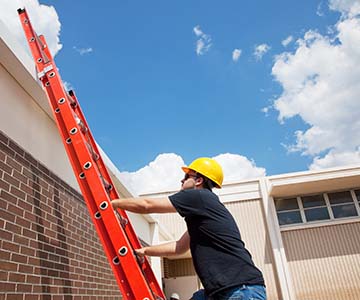SJVC Ontario students benefit from ladder safety training
 Students on the Ontario campus were shocked to learn how common – and preventable – ladder accidents are nationwide. Roughly 10,000 serious injuries occur each year and between 200-300 fatalities are reported.
Students on the Ontario campus were shocked to learn how common – and preventable – ladder accidents are nationwide. Roughly 10,000 serious injuries occur each year and between 200-300 fatalities are reported.
Those serious injuries run from sprained muscles and broken bones to life-altering concussions and loss of limb and sight, and occur largely among construction workers. But a surprising number of these injuries happen to those weekend warriors who are cleaning out their home’s rain gutters, installing outside safety lights, alarms and cameras, or hanging holiday lights.
March’s Ladder Safety Awareness Month inspired faculty members this year to initiate a ladder safety program that is now conducted in every class for all students to benefit. “It’s a whole culture we’re trying to introduce here that students will carry into their careers and at home,” says Andria Marrs, Construction Management Faculty Member and OSHA (Occupational Safety and Health Administration) Outreach Trainer. OSHA is an agency of the U.S. Department of Labor.
“It began when Jeanie Danforth, who approves professional development for staff and faculty, encouraged me to partner up with Medical Assisting program instructor Sharon Cobb,” says Andria. “They ordered some DVDs and training materials for the first ladder safety/first aid class that was made up of staff and faculty. Once the training was fully developed, we offered it to students on campus.”
The safety training included lots of information and training that could affect lives on and off the job.
One-third of injuries are falls from heights using ladders, scaffolds and on roofs, and occur primarily at small residential construction sites. In ladder-related accidents, the primary accident causes were:
- 40% ladder moved
- 24% footing missed or slipped
- 18% lost balance
Safety practices include:
- Select proper sized ladder and inspect parts such as rungs, cleats and hooks
- Scan the worksite for clutter, obstructions and electrical hazards
- Make sure ladder footing is level and stable
- Extend the ladder 3 feet above the resting point
- Avoid standing on the top 3 rungs of the ladder
- Know the weight capacity of the ladder
One of the most important safety precautions is to maintain a 3-point contact of hands and feet with the ladder whenever possible.
Students also learned about the economic consequences of lost earnings. Statistics show that workers (primarily construction) lost earnings after being injured at work. Even three and a half years after their accident, they were not able to attain the earnings level they had before their accident.
Safety measures can dramatically impact the frequency of ladder-related accidents and their long-term financial losses.
In the last few months, over 100 students on the Ontario campus have participated in ladder safety training, which earned the campus Ladder Safety Training Ambassador status from the American Ladder Institute. Each student who successfully completed the training and passed course exams earned a safety training certificate.
Many employers of interest to Electrical Technology and Construction Management program graduates require this safety certification. “Employers are asking for this, and it helps our students to feel even better qualified and prepared for that position,” says Andria.
These safety classes have had an added benefit to some students. “After taking the OSHA portion of the training, a few students were encouraged to look for jobs in safety and pursue further training,” says Andria. “Some just really enjoyed the safety aspects of the class and will seek jobs that have a strong emphasis on safety. Some companies might need a Safety Inspector and they could step into that role.”
“I will add this certification to my other ones for my portfolio and on my resume,” says Raymond Salazar, Construction Management program student. “This will help me as I move up in my career.”
“All students who have earned certification can log onto the Institute’s website and retake the assessment program once a year to keep certification current,” says Andria.
Next up, the campus will explore other safety training provisions to be part of program curriculum. “Hearing Awareness Month focuses on safety aspects,” says Andria. “Studying hearing loss from such job site sounds as power tools and heavy machinery creates more opportunities to integrate safety awareness into our programs.”
It is a lifelong advantage. “These training classes will encourage students to keep that safety mentality even after they’re no longer a student here,” says Andria.
More stories about
Request Information
All fields using an asterik (*) are required.